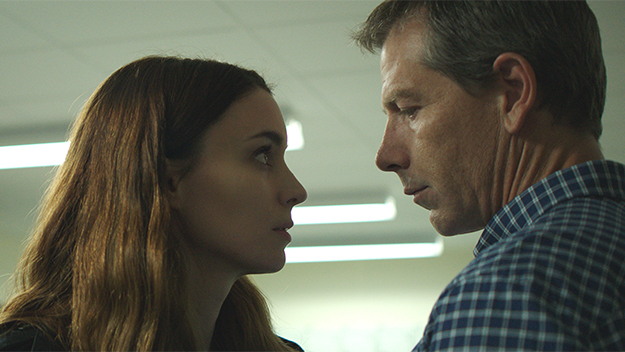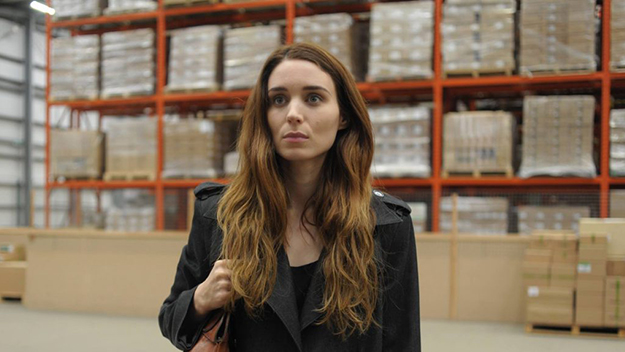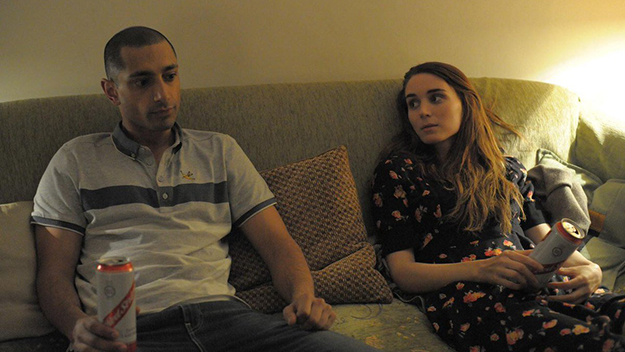Deep Focus: Una
The good and bad news about Una, the film version of David Harrower’s play Blackbird, is that it makes us want to see a first-rate stage production with the same two stars. In the title role, Rooney Mara imbues a grown victim of child sexual abuse with a piercing awareness of deep psychic wounds and a frightening cool volatility. Mara keeps us guessing about Una’s shifting feelings as well as her plans and motives and, throughout, we remain invested in her fate. Ben Mendelsohn brings his edgy presence and withering honesty to Una’s abuser, Ray, a neighbor who molested her for three months when she was 13, a decade and a half before, and even tried to run away with her. Mendelsohn limns Ray’s conflicts with a razor. He yearns to seem frank and “healthy”—he keeps saying he’s not “one of them,” that is, a pedophile—while battling his persistent attraction to Una and his need to justify his actions, past and present, no matter what. Both actors convey that their illicit and ruinous obsession still possesses them, body and soul, while they wrestle with their demons and each other.
It’s the director, sadly, who keeps breaking up their rhythm. Benedict Andrews, a stage veteran, went after Blackbird for his film debut because of his admiration for the play. (He directed the first German-language production, in Berlin, three months after its debut at the Edinburgh International Festival in 2005.) But in collaboration with Harrower, he opens it up and dilutes its power. I’ve read the play, not seen it, but poring through its pages made me imagine how brilliant Mara and Mendelsohn would be performing Una and Ray’s last tango as originally written, in real time, in a warehouse lunchroom, with no other actors around, just the shadowy presences of Ray’s colleagues glimpsed through frosted glass. In Una, Andrews not only expands the cast of characters and multiplies the settings, he also flashes back to the events of 15 years ago.
The director aims to amplify the real-world pressures that fuel and break this poisonous amour fou. He illustrates how Ray and Una created delicious (to them) private games, devising signals her parents couldn’t comprehend for the moments they could go out and play. (Ray was also a friend of her dad’s.) In the long buildup to the pair’s central confrontation, Andrews makes audiences wonder whether the adult Una has some murderous sport in mind when she tracks Ray down via a picture in a trade magazine, then surprises him at his workplace, where he rose to foreman under the name “Peter Trevelyan.”
All these artful embellishments short-circuit our imaginative connection to the drama and the pull of its stylized realism. We no longer must tease out the couple’s history between the lines of syncopated conversations. The published script often scans like blank verse—Una tells Ray, “I protected you. / Defended you. / Stayed / Stayed true.” Andrews breaks up the play’s tempo, whether with disturbing memories or a fraught worker/management meeting that Ray attends shortly after Una ambushes him. Andrews probably theorized that additional conflicts would amp up the suspense. Instead, they dissipate the mounting tension, because the director unveils current and past events at the same level of urgency, whether it’s a sexual moment of truth or a warehouse facing layoffs.
Ruby Stokes, who plays Una as a barely pubescent girl, pulls off heart-stabbing moments, notably at Ray’s trial, when Una starts her video testimony by telling him she loves him. Was Una the worst possible true love for an otherwise decent guy? Or was she his first target as a predator? Young Una’s scenes with Ray neither deepen our sense of their bond nor contribute to its Rashomon-like mysteries. The most they do is display Stokes’s skill at embodying errant curiosity and adolescent hurt and Mendelsohn’s gifts for portraying warped, furtive pleasures and wavering normality.
In an interview with London’s Independent, Andrews says he took Alain Resnais’s chronological scrambling in Hiroshima, Mon Amour as his key influence. But that’s an inflated comparison. When Resnais wasn’t juxtaposing a forbidden love affair in Occupied France with an agonized romance in recovering Hiroshima, he was intercutting the present-day lovers with footage of the A-bomb and its aftermath. Andrews merely illustrates a single ongoing story, while introducing other characters that don’t go anywhere, such as Una’s uncomprehending mom (Tara Fitzgerald). Scott, Ray’s right-hand man at work, is the most promising figure the film adds to the action. Riz Ahmed (HBO’s The Night Of, Nightcrawler) imbues the role with his sane, sympathetic presence; Una and her cryptic bond with his boss intrigue and confuse Scott, who is basically a good scout. Unfortunately, he functions as an intermediary for the audience, dampening the spark of incendiary material.
The film nearly expires before Andrews rouses it for one inspired invention: a cocktail party at the immaculate suburban home of Ray and his wife (Natasha Little) who married relatively recently. It generates cringe drama at its finest. Elsewhere, Una does suggest that Andrews, no born filmmaker, is a film director in the making. He cannily exploits the backdrop of the warehouse’s vast, anonymous spaces, especially when Scott and others hustle through its corridors in search of Ray as he and Una hide out from them. The blood-red color of the towering metal shelves slashes into the predominant browns and whites, as if echoing the way Una cuts into Ray’s bland, manufactured new life. And Andrews sets up some tingling visual echoes: at one point Una and Ray disappear into banks of lockers just as they once vanished into bushes.
Still, Mara and Mendelsohn are the ones who keep this movie alive and kicking. Una is a perfect role for Mara. It maximizes her unique talent for merging moments of clarity and confusion in a single fierce, oscillating current. At times she’s like a raw, unmoored version of the sales clerk Mara played in Carol (2015), blindsided by her own sexuality. Mendelsohn, for his part, is as good as he was in his underappreciated role as a bank robber’s mentor in The Place Beyond the Pines (2012). In that film, he assumed a stop-and-go delivery and a stumbling walk to fashion a dissembling character who also seemed disassembled and in need of replacement parts. In Una, he creates a broken man who thinks that all he needs is the right partner to be whole again. Throughout the movie, Ray tries to move with confidence, but the 28-year-old Una breaks his stride.
The two actors’ timing is marvelous. They salvage the force of the play’s splintered dialogue. In one devastating interchange, Ray, with an air of wisdom, tries to persuade Una that she was a highly unusual 13-year-old, “headstrong” and “determined,” and “sick of being treated like a child.” Una replies, “That’s what children say.”
Michael Sragow is a contributing editor to Film Comment and writes its Deep Focus column. He is a member of the National Society of Film Critics and the Los Angeles Film Critics Association. He also curates “The Moviegoer” at the Library of America website.










